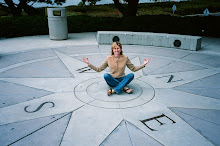

Dances with Cows
When I tell people I work as a Petersham Meadow Warden on the prettiest pasture on the planet, they snicker. What kind of policing could these placid bovines possibly need I muse. I follow the herd from apple orchard to kissing gate, holding my whirly-twirly behind my back. They get nervous when they see a stick and toss their heads-- heavy as concrete blocks.
As they huddle at the saltlick are they plotting to interlope on riparian picnics? Or perhaps the head-butting calves will get over-excited and bite an ear a la Mike Tyson?
The cows are earnest protectors of their calves. They will stand patiently while their calves nurse until they get their fill and creamy milk streams down their faces. But unless one is ill, or has a bee up her bum, they dislike being alone. They are a herd with a social order, and moo among themselves to make that clear.
These privileged cows are pastured at the verdant foot of Richmond Hill, framed on the west by the winding Thames, and on the east by the stately red brick and white stone Victorians cresting Richmond Hill. Since Sir Joshua Reynolds painted the view from his house in 1780, visitors have flocked to the hilltop to paint, snap and swoon at the view. In 1902 it became the only prospect protected by an Act of Parliament. While only specks from the hill, for centuries the cows have been a beloved feature of the Petersham water meadow below. Recently, the National Trust--the largest landowner in Europe--took over the management of the herd, and placed them under the watchful eyes of Ian, the chief cow herder, and his cadre of volunteers.
I didn't grow up on a farm, my only experience with large animals was gentling my mustang at the age of 13. Yet I find large animals impart an air of calm and grounding, not necessarily found with pets that share our living room, and mirror our anxieties. Of course, I love those too, how dogs and cats become family, add their measure of joy, and respond to our moods. But the livestock have a bit of wildness left in them. They read our character but make up their own minds whether they wish to respond. They permit the collaboration, but only just. And only if we keep up our part of the contract. Take care, pay attention, and don't interfere with their duties--calving, nursing, eating enough grass to sustain them (which is a long day and half a night's work) and ruminating.
Last season, and this spring, as I watch Fluffy and her cohorts tidily clipping grass, I have a hunch it's the cows that need protecting more than the people. Ramblers, toddlers, and tipplers snake through the kissing gate to reach the high water path to Petersham-- many unaware of the bovine mob inside. There are signs, more now that the National Trust has taken over the keeping of the cows, but few stop to read them. What ensues is an often charming, slightly surreal encounter.
Urbanites who dodge the most heinous London cabbies while gulping a latte and talking on their mobile are at a loss when it comes to making their way through a herd. They scan the meadow for human help, wondering who let the cows loose.
Others, emboldened by memories of petting zoos, reach out an apple or handful of grass. A rather big mistake.
But that's what we're there for--to intercept the well-meaning, but occasionally wrong-headed, and gently enforce the proper distance and disposition -- in the humans. I keep the whirly-twirly behind my back.
